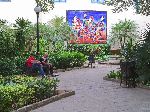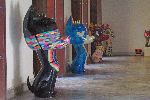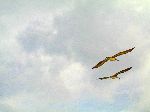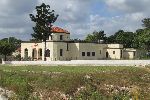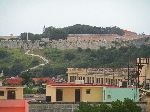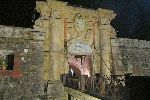| . | ||
Cuba
|
||
La Habana Vieja (Old Havana) |
||
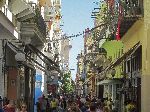
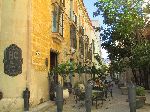
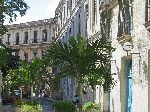
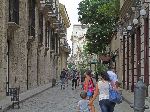 One
can plunge into La Habana Vieja (Old Havana). The city was
founded in 1519, so it has had a lot of time to develop its character(s). One
can plunge into La Habana Vieja (Old Havana). The city was
founded in 1519, so it has had a lot of time to develop its character(s). |
||
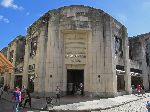 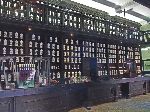 On the main commercial streets that are crowded with people, it is almost like launching into a river of people, and you are carried along. But many other streets have no crowds. Each new corner offers a view of different textures, shapes, design, colors, materials, scale and architecture. There are shops that look like they haven't changed since the 19th century, and building whose design put them squarely in the first half of the 20th century. Old Havana offers hundreds of "looks". In 1982, Old Havana was designated a UNESCO World Heritage Site. |
||
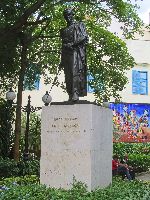 The
narrow street make old town seem packed, but these emerge on to open space large
and small; squares, plazas, and pocket parks. It is always a bit surprising how
much open space there is here. The
narrow street make old town seem packed, but these emerge on to open space large
and small; squares, plazas, and pocket parks. It is always a bit surprising how
much open space there is here.
The rest of the park is landscape with trees, shrubs and plants. The meander walkway has a few benches for those who want to stay a while to rest and relax and there is a colorful mural on the back wall. |
||
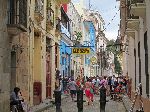 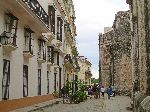 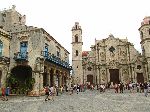 When
people originally began to buy plots in the area west of Castillo de la Real
Fuerza, middle 16th century, it was known as Plaza de la Ciénaga (Swamp
Square), because of the season hydrology. Over time it was drained and dried
out. In 1727, the work on the church that would give this plaza a greater
importance began. Eventually it came to be known as Plaza de la Catedral
(Cathedral Square). It was a very fashionable address with large houses (below), built by
Captain General Luis Chacón, (facing the Cathedral), former alderman Francisco
F. Ponce de León, Third Marquis of Aguas Claras (west of the Cathedral) and the
Count of Lombillo (corner of Empedrado Street) and the Marquis of Arcos, Royal
Treasurer. When
people originally began to buy plots in the area west of Castillo de la Real
Fuerza, middle 16th century, it was known as Plaza de la Ciénaga (Swamp
Square), because of the season hydrology. Over time it was drained and dried
out. In 1727, the work on the church that would give this plaza a greater
importance began. Eventually it came to be known as Plaza de la Catedral
(Cathedral Square). It was a very fashionable address with large houses (below), built by
Captain General Luis Chacón, (facing the Cathedral), former alderman Francisco
F. Ponce de León, Third Marquis of Aguas Claras (west of the Cathedral) and the
Count of Lombillo (corner of Empedrado Street) and the Marquis of Arcos, Royal
Treasurer. |
||

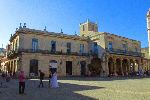
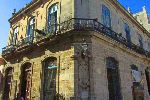 |
||
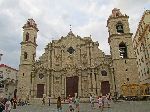 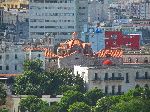 La
Catedral de la Virgen María de la Concepción Inmaculada de La Habana
(Cathedral of the Virgin Mary of the Immaculate Conception) was built from 1748
to 1777. The church was built in a Baroque style with several Tuscan elements
and is considered one of the best examples of Baroque architecture in Cuba. The
building is mainly constructed from blocks of coral cut from sources in the Gulf
of Mexico's ocean floor. Preserved marine fossils are present in the facade. The
cathedral's interior is in the neoclassical style. It has white and black marble
floors, three naves covered with wooden vaults, massive stone pillars, and eight
side chapels. Though it can't be view from the square, the Cathedral has a
distinctive eight panel red cupola, with a gazebo-like tower on top. La
Catedral de la Virgen María de la Concepción Inmaculada de La Habana
(Cathedral of the Virgin Mary of the Immaculate Conception) was built from 1748
to 1777. The church was built in a Baroque style with several Tuscan elements
and is considered one of the best examples of Baroque architecture in Cuba. The
building is mainly constructed from blocks of coral cut from sources in the Gulf
of Mexico's ocean floor. Preserved marine fossils are present in the facade. The
cathedral's interior is in the neoclassical style. It has white and black marble
floors, three naves covered with wooden vaults, massive stone pillars, and eight
side chapels. Though it can't be view from the square, the Cathedral has a
distinctive eight panel red cupola, with a gazebo-like tower on top. |
||

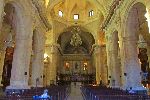
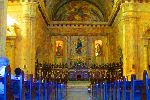
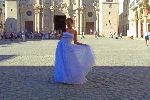 One
young lady was using Cathedral Square as a location for a photo shoot for her
quinceañera album. One
young lady was using Cathedral Square as a location for a photo shoot for her
quinceañera album. |
||
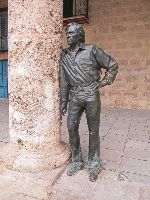 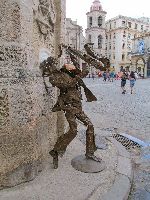 Realistic,
full size bronze figures - standing, sitting and contemplating - are a popular
form of public art in Havana. Some of the subjects are artists and intellectual with
international reputation, but not always. Some of the most popular are cultural
figure unique to Havana lore. Also in the mix are living statues that move from
location to location during the day. The permanent installations are often
designed to be photographed with. The living statues make their living being
photographed. Realistic,
full size bronze figures - standing, sitting and contemplating - are a popular
form of public art in Havana. Some of the subjects are artists and intellectual with
international reputation, but not always. Some of the most popular are cultural
figure unique to Havana lore. Also in the mix are living statues that move from
location to location during the day. The permanent installations are often
designed to be photographed with. The living statues make their living being
photographed.In Cathedral Square, there are bronze sculptures of Antonia Gades and a saxophone player. Antonio Gades (1936-2004), by José Villa
Soberón, leans against a pillar in front of
the Palacio de Lombillo. Gades was a Spanish flamenco dancer and choreographer.
Soberón is from Santiago de Cuba. The musician (right) is outside of a jazz club. Also in the portico of Palacio de Lombillo, in the shadow of the cathedral, a fortune teller practices her trade (far right). |
||
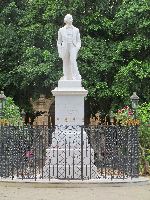  The
next major square is Plaza de Armas. In the middle is a statue honoring Carlos Manuel de Cespedes. The
inscription on the statue says, "Carlos Manuel de Céspedes,
Padre de la Patria y Primer Presidente de la Republica, el Pueblo de Cuba, en el
Cincuentenario de la Independence." (Carlos Manuel de Céspedes, Father of
the Fatherland and First President of the Republic, the People of Cuba, on the
Fiftieth Anniversary of Independence.) Céspedes was born Bayamo, in eastern
Cuba, into a wealthy family. As an adult, he was a lawyer, poet, writer, and
planter. He is revered for having freed his slaves and for making a declaration
of Cuban independence in 1868. The insurrection last ten years. He served as the
president of the revolutionary government from 1869 to 1873. Eventually, the
Spanish crushed the movement and regain control of the country. Céspedes The
next major square is Plaza de Armas. In the middle is a statue honoring Carlos Manuel de Cespedes. The
inscription on the statue says, "Carlos Manuel de Céspedes,
Padre de la Patria y Primer Presidente de la Republica, el Pueblo de Cuba, en el
Cincuentenario de la Independence." (Carlos Manuel de Céspedes, Father of
the Fatherland and First President of the Republic, the People of Cuba, on the
Fiftieth Anniversary of Independence.) Céspedes was born Bayamo, in eastern
Cuba, into a wealthy family. As an adult, he was a lawyer, poet, writer, and
planter. He is revered for having freed his slaves and for making a declaration
of Cuban independence in 1868. The insurrection last ten years. He served as the
president of the revolutionary government from 1869 to 1873. Eventually, the
Spanish crushed the movement and regain control of the country. Céspedes |
||
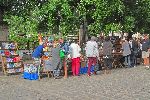 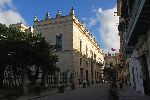 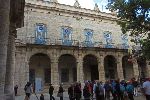 In
the streets on edge of Plaza de Armas is a book and antique market. In
the streets on edge of Plaza de Armas is a book and antique market.On the side of the plaza is the Palacio de los Capitanes Generales (Governors house), Palacio del Segundo Cabo and other former houses of the wealthy. |
||
 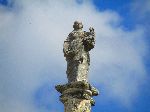 El
Templete is a monument that pays homage to the place where the foundation of the
town of San Cristóbal de la Habana was celebrated in 1519. At the front of the
site is the Column of Cajigal (1754), honoring the original Ceiba tree that grew
at this location, and under which the first mass of Havana was celebrated. At
the top of the column is an image of the Virgin of Pilar de Zaragoza, patroness
of Spanish sailors. A marble bust of Governor Don Hernando de Soto, who was the
first governor of the town of San Cristobal de La Habana, is at the base of the
column. Towards the rear is El Tempete, a small neoclassic building (1827), with
six plain Greek Doric columns, typical example of colonial architecture. Inside
is a small bust of Christopher Columbus and three canvases, painted by the
Frenchmen Jean Baptiste Vermay, depicting the celebration of the first mass, the
first town council and the blessing of the site. El
Templete is a monument that pays homage to the place where the foundation of the
town of San Cristóbal de la Habana was celebrated in 1519. At the front of the
site is the Column of Cajigal (1754), honoring the original Ceiba tree that grew
at this location, and under which the first mass of Havana was celebrated. At
the top of the column is an image of the Virgin of Pilar de Zaragoza, patroness
of Spanish sailors. A marble bust of Governor Don Hernando de Soto, who was the
first governor of the town of San Cristobal de La Habana, is at the base of the
column. Towards the rear is El Tempete, a small neoclassic building (1827), with
six plain Greek Doric columns, typical example of colonial architecture. Inside
is a small bust of Christopher Columbus and three canvases, painted by the
Frenchmen Jean Baptiste Vermay, depicting the celebration of the first mass, the
first town council and the blessing of the site. |
||
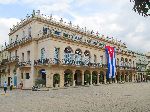  This
house, Casa de Juana Carvajal, dates from the early 17th century, making
it the oldest on this stretch of Cuba Tacón.
It acquired its present Spanish Colonial appearance in 1725. It has fantastic
18th century murals inside. In 1988 it was restored as the headquarters of the
Gabinete de Arqueología (Archeology Department of the City Historian’s Office)
and is the Museo de Arqueología. It is noted for its exhibition of pre-Columbian
art, vessels and textiles. This
house, Casa de Juana Carvajal, dates from the early 17th century, making
it the oldest on this stretch of Cuba Tacón.
It acquired its present Spanish Colonial appearance in 1725. It has fantastic
18th century murals inside. In 1988 it was restored as the headquarters of the
Gabinete de Arqueología (Archeology Department of the City Historian’s Office)
and is the Museo de Arqueología. It is noted for its exhibition of pre-Columbian
art, vessels and textiles. |
||
 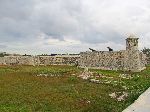 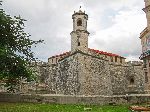 The
need for the defense of the city was recognized early on. An earlier fort
proved to be ineffective. In response, in 1558 construction of Castillo
de la Real Fuerza (Castle of the Royal Force) was begun. It was built at
the edge of Old Town. It is an excellent exemplar of a star fort, but it was
still located too far inside the harbor and was too
small to be of any strategic importance. The
need for the defense of the city was recognized early on. An earlier fort
proved to be ineffective. In response, in 1558 construction of Castillo
de la Real Fuerza (Castle of the Royal Force) was begun. It was built at
the edge of Old Town. It is an excellent exemplar of a star fort, but it was
still located too far inside the harbor and was too
small to be of any strategic importance. |
||
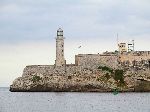 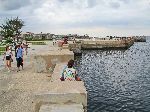 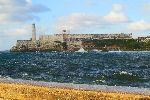 The defense of the city was again addressed with the construction Castillo de San Salvador de la Punta (1590-1630) (left) and Castillo de los Tres Reyes del Morro (1589) (right) on opposing sides of the mouth of Havana Bay. The city and harbor were further protected by a heavy chain strung between the two forts, that could be raised and lowered. The Faro Castillo del Morro lighthouse was added in 1846. |
||
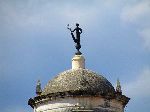 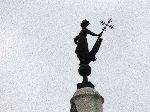 In 1634, Juan Vitrián de Viamonte
added a watchtower with a weathervane sculpted in the form of a woman, by
Gerónimo Martín Pinzón, an artist from Havana, and based on the figure
crowning La Giralda in Seville. Although the reason for the choice of this
figure, called La Giraldilla, is not known, a common suggestion is to
honor Inés de Bobadilla, Havana's only female governor, who assumed control
from her husband Hernando de Soto when he undertook an expedition to
Florida. She spent many years scanning the horizon for signs of his
returning ship (unbeknownst to her, he had died). The figure became the
symbol of the city of Havana (it features on the Havana Club rum label). A
replica now graces the watchtower. In 1634, Juan Vitrián de Viamonte
added a watchtower with a weathervane sculpted in the form of a woman, by
Gerónimo Martín Pinzón, an artist from Havana, and based on the figure
crowning La Giralda in Seville. Although the reason for the choice of this
figure, called La Giraldilla, is not known, a common suggestion is to
honor Inés de Bobadilla, Havana's only female governor, who assumed control
from her husband Hernando de Soto when he undertook an expedition to
Florida. She spent many years scanning the horizon for signs of his
returning ship (unbeknownst to her, he had died). The figure became the
symbol of the city of Havana (it features on the Havana Club rum label). A
replica now graces the watchtower. |
||
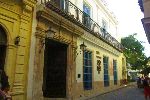 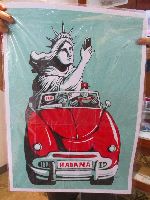
Across the street is a gallery with a large cat theme. Another nearby shop is the edgy and cutting-edge Clandestina boutique. They make many of their statements with humor. The poster commentary on international tourism (right) was in their rack. |
||

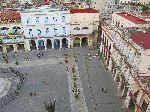
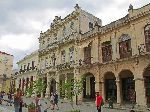
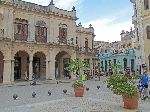
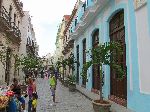 |
||
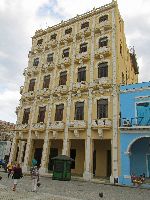  The
square that is now called Plaza Vieja (Old Square) was originally
called Plaza Neuva. It emerged as an open space in 1559. In colonial
times, it was a residential neighborhood of the Criollo plutocracy, and is
still boarded by large residential buildings, with balconies overlooking the
square. In between its old and new designation, in the eighteenth century, the
square was turned into a popular market, and was called Plaza del Mercado
(Market Square) as Havana's commercial hub. The market was relocated from
Plaza de San Francisco because the monks complained about the noise. In the
1800, most of the street level retail activity migrated to other location, and
the square is now quite subdued. The original fountain in the plaza was
destroyed in the 1930's, and is now being restored (2016). A modern sculpture
(palm tree?) has also been added to the square, but seems out of character. The
square that is now called Plaza Vieja (Old Square) was originally
called Plaza Neuva. It emerged as an open space in 1559. In colonial
times, it was a residential neighborhood of the Criollo plutocracy, and is
still boarded by large residential buildings, with balconies overlooking the
square. In between its old and new designation, in the eighteenth century, the
square was turned into a popular market, and was called Plaza del Mercado
(Market Square) as Havana's commercial hub. The market was relocated from
Plaza de San Francisco because the monks complained about the noise. In the
1800, most of the street level retail activity migrated to other location, and
the square is now quite subdued. The original fountain in the plaza was
destroyed in the 1930's, and is now being restored (2016). A modern sculpture
(palm tree?) has also been added to the square, but seems out of character. |
||
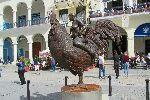
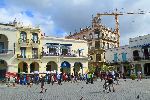 Another
new addition to the plaza is a larger than life "Viaje Fantastico" by Roberto
Fabelo. It is a sculpture of a woman riding a
rooster. The woman wears no clothes and is carrying a fork that is more in scale
with the chicken. So far, we haven't discovered an allegory. Another
new addition to the plaza is a larger than life "Viaje Fantastico" by Roberto
Fabelo. It is a sculpture of a woman riding a
rooster. The woman wears no clothes and is carrying a fork that is more in scale
with the chicken. So far, we haven't discovered an allegory.With the new there is an effort to hang on to the old, with the restoration of a building at the end of the plaza. |
||
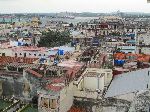 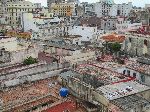 For
a fee, you can get to the roof of the five-story building in the corner of Plaza Vieja. The amusement is a periscope above the roof of the building that rotates
and projects the skyline of the city on a round disk, but the real value is
access to the roof and a first-hand view of the skyline. Even at this, it is not
a great skyline, but it is a different view and orientation, if you are
interested in the layout of the city. For
a fee, you can get to the roof of the five-story building in the corner of Plaza Vieja. The amusement is a periscope above the roof of the building that rotates
and projects the skyline of the city on a round disk, but the real value is
access to the roof and a first-hand view of the skyline. Even at this, it is not
a great skyline, but it is a different view and orientation, if you are
interested in the layout of the city. |
||
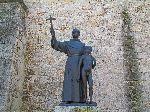 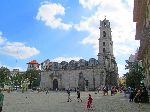 Plaza
de San Francisco (San
Francisco Square) is so named because of the convent next to it, Basílica San Francisco
de Asis. It was conceived in 1628, with the objective of collecting
water to supply to the ships
trading with the metropolis. Plaza
de San Francisco (San
Francisco Square) is so named because of the convent next to it, Basílica San Francisco
de Asis. It was conceived in 1628, with the objective of collecting
water to supply to the ships
trading with the metropolis.The statue outside is of Saint Junipero Serra y Ferrer, and Juaneño boy (an indigenous people from the southern California coast). Serra (1713-1784) was a Spanish Roman Catholic priest and friar of the Franciscan Order, who founded the first nine Spanish missions in California. He was canonized in 2015. This was not without controversy because of what some consider his suppression of Native American culture. He was considered intellectually brilliant by his peers. There is no mention of Saint Serra working in Cuba. |
||
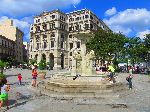 The
1836 fountain in the plaza is made of white Carrara marble by
Italian architect Giuseppe Gaggini, under the auspices of the Villanueva Count.
It is the same sculpture who did Fuente de la India in Central Havana. This fountain is
called Fuente de los Leones (Lions Fountain). There are four lions, one
to each corner, resting on pedestals with water flowing from their mouths. The
1836 fountain in the plaza is made of white Carrara marble by
Italian architect Giuseppe Gaggini, under the auspices of the Villanueva Count.
It is the same sculpture who did Fuente de la India in Central Havana. This fountain is
called Fuente de los Leones (Lions Fountain). There are four lions, one
to each corner, resting on pedestals with water flowing from their mouths. |
||
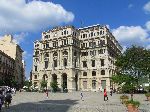 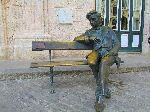  At the opposite end of the plaza from St. Serra, and in front of Lonja del
Comercio (Trade Market) (1909), is a very engaging modern sculpture, "La conversación",
by French sculptor Etienne. At the opposite end of the plaza from St. Serra, and in front of Lonja del
Comercio (Trade Market) (1909), is a very engaging modern sculpture, "La conversación",
by French sculptor Etienne.To the side of the plaza, Federico Chopin (1910-1849) (far right) sits and watches the parade of activity. |
||
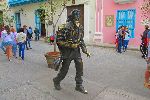 There is also a bronze statue of El Caballero de
Paris (the Gentleman of Paris) (1899-1985) (created by the
sculptor José Villa Soberón) and an unnamed street musician. El
Caballero, a Spaniard, was a well-known street person in Havana, who wandered
all over town. El Caballero, though kind, articulate and philosophical,
had a certain mystery about him and was the inspiration for dozens of legends
and creative works. He never begged and only took money from people he knew. There is also a bronze statue of El Caballero de
Paris (the Gentleman of Paris) (1899-1985) (created by the
sculptor José Villa Soberón) and an unnamed street musician. El
Caballero, a Spaniard, was a well-known street person in Havana, who wandered
all over town. El Caballero, though kind, articulate and philosophical,
had a certain mystery about him and was the inspiration for dozens of legends
and creative works. He never begged and only took money from people he knew. |
||
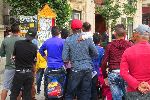  There
are often family oriented programs on the side of San Francisco Plaza. On
one set of consecutive days there was a puppet show one day (left), and on
the other an enactment of a colonial period drama addressing some aspect of
slavery (right). There
are often family oriented programs on the side of San Francisco Plaza. On
one set of consecutive days there was a puppet show one day (left), and on
the other an enactment of a colonial period drama addressing some aspect of
slavery (right). |
||
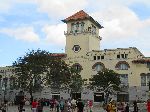
The bird of the Bay of Havana is the pelican. Though, perhaps designed by committee, they are a delight to watch. |
||
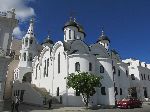 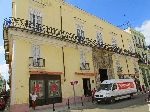 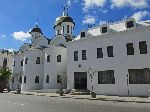 Catedral
Ortodoxa Nuestra Señora de Kazán is Havana's Byzantine-style Russian
Orthodox Church. The church was consecrated in October 2008. The church was
an initiative of Fidel Castro. According to his memoirs the church is a
"monument to Russion-Cuban friendship." It provides as another reflection of
the ethnic and religious diversity in the Cuban capital. Catedral
Ortodoxa Nuestra Señora de Kazán is Havana's Byzantine-style Russian
Orthodox Church. The church was consecrated in October 2008. The church was
an initiative of Fidel Castro. According to his memoirs the church is a
"monument to Russion-Cuban friendship." It provides as another reflection of
the ethnic and religious diversity in the Cuban capital.Incidentally, down the street is the Havana Club Factory (far right) - producer of consumer beverages. |
||
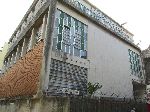 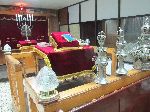 The
synagogue in old Havana is Adath Israel. It was formed by Eastern European
Jews, from Russia and Poland, who arrived in Havana after WWI. It is
located in the southern part of old Havana, which once was the Jews
quarters. The building doesn't have much of a street presence, but social
hall
is nicely crafted and has a very high ceiling. The high bank of windows the
length of the sanctuary, and around the corners, fill it natural light
during the day. The sanctuary is on a lower floor. The
synagogue in old Havana is Adath Israel. It was formed by Eastern European
Jews, from Russia and Poland, who arrived in Havana after WWI. It is
located in the southern part of old Havana, which once was the Jews
quarters. The building doesn't have much of a street presence, but social
hall
is nicely crafted and has a very high ceiling. The high bank of windows the
length of the sanctuary, and around the corners, fill it natural light
during the day. The sanctuary is on a lower floor. |
||
  A
statue of a Greek Orthodox Priest is a
gift from the church and people of Cyprus to the people of Cuba. A
statue of a Greek Orthodox Priest is a
gift from the church and people of Cyprus to the people of Cuba.
A statue of Nicolás Cristóbal Guillén Batista (1902-1989), overlooking Havana Bay, is placed on Alameda (mall) de Paula. Guillen was a Cuban poet, writer, journalist, and political activist against the repressive regimes from the 1930s-50s, for which he was jailed and exiled. As a poet, Guillén's fame as one of the premier poets of the Négritude movement. After the revolution, and back in Cuba, Fidel appointed him to the post of president of the National Cuban Writers' Union, which he held from 1961 to 1986. Guillén is now best remembered as the national poet of Cuba. |
||
 Construction
works began in 1668 on Iglesia de San Francisco de Paula and a woman's hospital.
In 1730, a hurricane destroyed the church, which was rebuilt 10 years later in
Baroque style. In 1907, Havana Central Railroad, a US company, tried to acquire
the temple to transform it into a warehouse. Fortunately, the company’s several
attempts to demolish the church were stopped by the opposition of several Cuban
intellectuals, including historian Emilio Roig de Leuchsenring and
anthropologist don Fernando Ortiz. Their efforts not only stopped the demolition
of the church, but also got it listed as National Monument in 1944. Havana
Central Railroads, however, was able to demolish the hospital upon approval
from the relevant authorities. The stained-glass windows of the church have been fully
restored by the Office of the City Historian and are quite a sight. It is
considered by many one of the most precious jewels of Havana’s heritage. Construction
works began in 1668 on Iglesia de San Francisco de Paula and a woman's hospital.
In 1730, a hurricane destroyed the church, which was rebuilt 10 years later in
Baroque style. In 1907, Havana Central Railroad, a US company, tried to acquire
the temple to transform it into a warehouse. Fortunately, the company’s several
attempts to demolish the church were stopped by the opposition of several Cuban
intellectuals, including historian Emilio Roig de Leuchsenring and
anthropologist don Fernando Ortiz. Their efforts not only stopped the demolition
of the church, but also got it listed as National Monument in 1944. Havana
Central Railroads, however, was able to demolish the hospital upon approval
from the relevant authorities. The stained-glass windows of the church have been fully
restored by the Office of the City Historian and are quite a sight. It is
considered by many one of the most precious jewels of Havana’s heritage. |
||
| At various places, it is hard to tell whether the gravel in the streets of old Havana is from the building crumbling or being restored, or some of both. It is a gem of a city with quaint narrow "old world" pedestrian only streets, wide boulevards, museums, churches, art galleries, craft markets, history and a lot of life. | ||
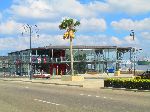 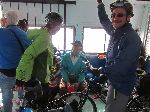 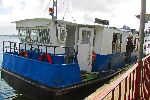 The
easiest way for pedestrians and bicyclists to cross Havana Harbor is by
the passenger ferries. For Cubans, the cost of a trip is one peso (about US$0.04)
There are frequent boats to the communities of Casablanca and Regla. The
easiest way for pedestrians and bicyclists to cross Havana Harbor is by
the passenger ferries. For Cubans, the cost of a trip is one peso (about US$0.04)
There are frequent boats to the communities of Casablanca and Regla. |
||
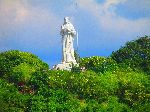 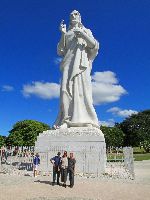 The
focal point of Casablanca is Christo
de la Habana, who stands on top La Cabaña Hill,
above Casablanca. It is the work
of the Cuban sculptor Jilma Madera, who won the commission for it in 1953. It is
constructed from 67 blocks of white Carrara marble, brought from Italy. It was
inaugurated on December 24, 1958 - in the last days of the Batista regime. The
focal point of Casablanca is Christo
de la Habana, who stands on top La Cabaña Hill,
above Casablanca. It is the work
of the Cuban sculptor Jilma Madera, who won the commission for it in 1953. It is
constructed from 67 blocks of white Carrara marble, brought from Italy. It was
inaugurated on December 24, 1958 - in the last days of the Batista regime. |
||
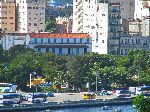
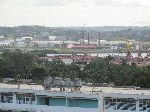
 Cabaña
Hill provides an excellent vantage point to survey the economy and
history of Havana. From there you can peer down on Old Havana (left), spot the
rum factory across town (right) and located the industrial zone (far right),
which most visitors are unaware of. Cabaña
Hill provides an excellent vantage point to survey the economy and
history of Havana. From there you can peer down on Old Havana (left), spot the
rum factory across town (right) and located the industrial zone (far right),
which most visitors are unaware of. |
||
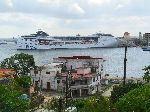 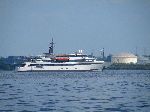 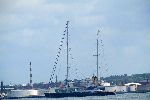 Besides
an almost daily cruise ship (left) in rotation at the San Francisco Terminal, in
Havana, it is common to see multi-million dollar super yachts on anchor in
Havana Bay. It is a curiosity that these supper capitalists are taking a break
from their maximization of profit and extraction of wealth, to spread some petty
cash and nibble on a little
socialism. Besides
an almost daily cruise ship (left) in rotation at the San Francisco Terminal, in
Havana, it is common to see multi-million dollar super yachts on anchor in
Havana Bay. It is a curiosity that these supper capitalists are taking a break
from their maximization of profit and extraction of wealth, to spread some petty
cash and nibble on a little
socialism. |
||

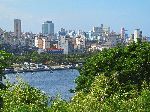 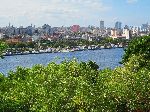 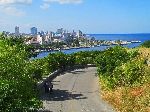
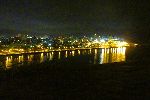 |
||
| The Havana skyline as seen from el Christo, Cabaña Hill (above). Lining Avenue del Puerto (an extension of the Malacon), outside Old Havana, are twenty-plus, parked tour buses - at times there are many times more. | ||
|
|
||
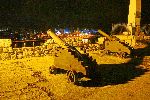 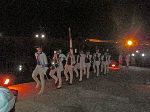 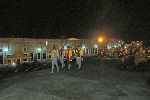 Now-a-days the fortress attracts tourists every night for a ten-minute
performance - stretched over 15 minutes - and cannon shot at 9pm. Because there is such a long
burn time for the fuse, and he cannon booms every night at exact 9pm, a cynic
would postulate that most of this is for show and the actual detonation is done
electronically. In times past the discharge signaled the
closing of the city gates and the raising of a chain across the harbor for the
night. Now-a-days the fortress attracts tourists every night for a ten-minute
performance - stretched over 15 minutes - and cannon shot at 9pm. Because there is such a long
burn time for the fuse, and he cannon booms every night at exact 9pm, a cynic
would postulate that most of this is for show and the actual detonation is done
electronically. In times past the discharge signaled the
closing of the city gates and the raising of a chain across the harbor for the
night. |
||
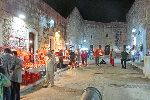 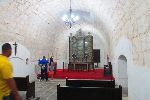 Not
a country to miss an opportunity for merchandising, tourist can arrive early and
peruse another craft market (left). The chapel is also open (right) and there
are a few simple exhibits on weaponry, helmets and armaments. Not
a country to miss an opportunity for merchandising, tourist can arrive early and
peruse another craft market (left). The chapel is also open (right) and there
are a few simple exhibits on weaponry, helmets and armaments.The most intriguing contraption on display. is a ramrod that features a cast rams head at the end of the ramrod (lower right). |
||
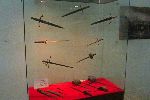
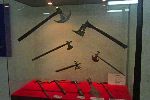
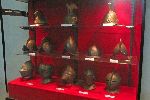
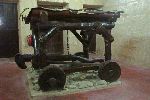
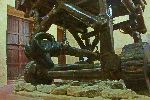 |
||
 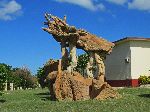 Across
the road from el Christo is the helping
hand sculpture in front of the Civil Defense Directorate. It is
dedicated to the people of Cuba for their solidarity in at the time of natural
disasters. The sculpture, by Cuban sculptor Andrés González González, depicts
hands reaching up and reach down and grasping wrists. Cuban civil defense
responses to disasters like floods, hurricanes, tornados, wildfires,
earthquakes, etc. Across
the road from el Christo is the helping
hand sculpture in front of the Civil Defense Directorate. It is
dedicated to the people of Cuba for their solidarity in at the time of natural
disasters. The sculpture, by Cuban sculptor Andrés González González, depicts
hands reaching up and reach down and grasping wrists. Cuban civil defense
responses to disasters like floods, hurricanes, tornados, wildfires,
earthquakes, etc.On the road, a group hanging out of skateboarders hangout. Perhaps they are congregated at this location because the road descends from here to Casablanca. |
||
 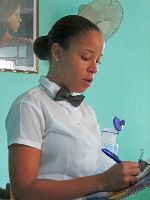 This
is dedicated to a wonderful lunch and experience at a family restaurant along
Carretera del Asilo, and our interaction with the family. The meal delivered to
the table was called "Land and Sea". It included patters of brilliantly spiced
and prepared shrimp, fish, chicken, pork, morro (flavored rice and beans) and
salad. Each dish was mouth-watering. The family was wonderfully responsive,
accommodating and engaging hosts - bicyclists can have a lot of needs for water,
bathrooms, etc. This
is dedicated to a wonderful lunch and experience at a family restaurant along
Carretera del Asilo, and our interaction with the family. The meal delivered to
the table was called "Land and Sea". It included patters of brilliantly spiced
and prepared shrimp, fish, chicken, pork, morro (flavored rice and beans) and
salad. Each dish was mouth-watering. The family was wonderfully responsive,
accommodating and engaging hosts - bicyclists can have a lot of needs for water,
bathrooms, etc. |
||
|
Central
|
||
    |
||
|
"Hosted by
DreamHost - earth friendly web hosting"
|
||
|
|
|
